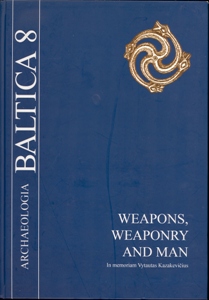Volume 8 (2007): Weapons, Weaponry and Man (In memoriam Vytautas Kazakevičius), November 2007

Order by:
Pub. online: 9 Nov 2007
Type: Article
 Open Access
Open Access
Journal:
Archaeologia Baltica
Volume 8 (2007): Weapons, Weaponry and Man (In memoriam Vytautas Kazakevičius), pp. 292–301
Abstract
The Meaning of Weapons as Grave Goods: Examples from Two Southwest Finnish Crusade Period Cemeteries
Pub. online: 9 Nov 2007
Type: Article
 Open Access
Open Access
Journal:
Archaeologia Baltica
Volume 8 (2007): Weapons, Weaponry and Man (In memoriam Vytautas Kazakevičius), pp. 302–309
Abstract
Pub. online: 9 Nov 2007
Type: Article
 Open Access
Open Access
Journal:
Archaeologia Baltica
Volume 8 (2007): Weapons, Weaponry and Man (In memoriam Vytautas Kazakevičius), pp. 310–320
Abstract
Pub. online: 9 Nov 2007
Type: Article
 Open Access
Open Access
Journal:
Archaeologia Baltica
Volume 8 (2007): Weapons, Weaponry and Man (In memoriam Vytautas Kazakevičius), pp. 321–327
Abstract
Pub. online: 9 Nov 2007
Type: Article
 Open Access
Open Access
Journal:
Archaeologia Baltica
Volume 8 (2007): Weapons, Weaponry and Man (In memoriam Vytautas Kazakevičius), pp. 328–333
Abstract
Pub. online: 9 Nov 2007
Type: Article
 Open Access
Open Access
Journal:
Archaeologia Baltica
Volume 8 (2007): Weapons, Weaponry and Man (In memoriam Vytautas Kazakevičius), pp. 334–346
Abstract
Pub. online: 9 Nov 2007
Type: Article
 Open Access
Open Access
Journal:
Archaeologia Baltica
Volume 8 (2007): Weapons, Weaponry and Man (In memoriam Vytautas Kazakevičius), pp. 347–359
Abstract
Traumatic Lesions in Human Osteological Remains from the Daugava Area (Seventh to 17th Centuries AD)
Pub. online: 9 Nov 2007
Type: Article
 Open Access
Open Access
Journal:
Archaeologia Baltica
Volume 8 (2007): Weapons, Weaponry and Man (In memoriam Vytautas Kazakevičius), pp. 360–367
Abstract
Pub. online: 9 Nov 2007
Type: Article
 Open Access
Open Access
Journal:
Archaeologia Baltica
Volume 8 (2007): Weapons, Weaponry and Man (In memoriam Vytautas Kazakevičius), pp. 368–376
Abstract
Pub. online: 9 Nov 2007
Type: Article
 Open Access
Open Access
Journal:
Archaeologia Baltica
Volume 8 (2007): Weapons, Weaponry and Man (In memoriam Vytautas Kazakevičius), pp. 377–386
Abstract